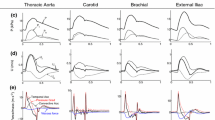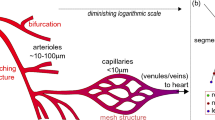Abstract
By definition, vascular impedance is described in the frequency domain as the ratio of sinusoidal functions of pressure and flow, yielding spectral values of impedance modulus and phase. The impedance spectrum is determined by the structure and physical properties of the vascular system, such that for a given system the relation between pressure and flow can be modified by alteration of the geometric or mechanical properties of the vascular segments. Whereas input impedance of an arterial system can be readily determined by simultaneous measurement of just two time varying signals of blood pressure and flow, the production of the same impedance spectrum from the physical properties of the system would require information of inordinate complexity and magnitude. Hence, arterial models with a tractable number of parameters or explicit mathematical description are used to approximate the physiological impedance of a vascular structure, which in all animal species consists of distributed branching arterial networks. Although models are a necessary approximation, the strong similarity between the impedance spectra of models and physiological arterial systems enables investigations of fundamental concepts. This is illustrated by examining the effect of the branching structure on the decoupling of the high peripheral resistance from the ejecting ventricles and how physical parameters derived from the impedance spectrum can be used to investigate concepts of optimal design and features related to body size across a broad range of animal species.





Similar content being viewed by others
References
Avolio AP, O’Rourke MF, Mang K, Bason PT, Gow BS (1976) A comparative study of pulsatile arterial hemodynamics in rabbits and guinea pigs. Am J Physiol 230(4):868–875
Avolio AP, O’Rourke MF, Webster ME (1983) Pulse-wave propagation in the arterial system of the diamond python Morelia spilotes. Am J Physiol 245(6):R831–R836
Avolio AP (1980) Multi-branched model of the human arterial system. Med Biol Eng Comput 18(6):709–718. doi:10.1007/BF02441895
Avolio AP (1976) Haemodynamic studies and modeling of the mammalian arterial system. PhD Thesis, University of New South Wales, Sydney
Bennett SH, Goetzman BW, Milstein JM, Pannu JS (1996) Role of arterial design on pulse wave reflection in a fractal pulmonary network. J Appl Physiol 80(3):1033–1056
Brown DJ (1996) Input impedance and reflection coefficient in fractal-like models of asymmetrically branching compliant tubes. IEEE Trans Biomed Eng 43(7):715–722. doi:10.1109/10.503179
Burattini R, Di Carlo S (1988) Effective length of the arterial circulation determined in the dog by aid of a model of the systemic input impedance. IEEE Trans Biomed Eng 35(1):53–61. doi:10.1109/10.1336
Elzinga G, Westerhof N (1991) Matching between ventricle and arterial load. An evolutionary process. Circ Res 68(6):1495–1500
Grasman J, Brascamp JW, Van Leeuwen JL, Van Putten B (2003) The multifractal structure of arterial trees. J Theor Biol 220(1):75–82
Günther B (1975) Dimensional analysis and theory of biological similarity. Physiol Rev 55(4):659–699
Heymsfield SB, Childers D, Beetsch J, Allison DB, Pietrobelli A (2007) Body size and human energy requirements: reduced mass specific resting energy expenditure in tall adults. J Appl Physiol 103:1543–1550. doi:10.1152/japplphysiol.00461.2007
Hlastala MP, Glenny RW (1999) Vascular structure determines pulmonary blood flow distribution. News Physiol Sci 14:182–186
Karamanoglu M, Gallagher DE, Avolio AP, O’Rourke MF (1994) Functional origin of reflected pressure waves in a multibranched model of the human arterial system. Am J Physiol 267(5 Pt 2):H1681–H1688
Karamanoglu M, Gallagher DE, Avolio AP, O’Rourke MF (1995) Pressure wave propagation in a multibranched model of the human upper limb. Am J Physiol 269(4 Pt 2):H1363–H1369
Kassab GS (2006) Scaling laws of vascular trees: of form and function. Am J Physiol Heart Circ Physiol 290(2):H894–H903. doi:10.1152/ajpheart.00579.2005
Krenz GS, Linehan JH, Dawson CA (1992) A fractal continuum model of the pulmonary arterial tree. J Appl Physiol 72(6):2225–2237
Lefèvre J (1983) Teleonomical optimization of a fractal model of the pulmonary arterial bed. J Theor Biol 102(2):225–248. doi:10.1016/0022-5193(83)90361-2
Li JK, Noordergraaf A (1991) Similar pressure pulse propagation and reflection characteristics in aortas of mammals. Am J Physiol 261(3 Pt 2):R519–R521
Li JKJ (1996) Comparative cardiovascular dynamics of mammals. CRC Press, Boca Raton, pp 23–57
Milnor WR, Conti CR, Lewis KB, O’Rourke MF (1969) Pulmonary arterial pulse wave velocity and impedance in man. Circ Res 25(6):637–649
Milnor WR (1979) Aortic wavelength as a determinant of the relation between heart rate and body size in mammals. Am J Physiol 237(1):R3–R6
Mohiuddin MW, Laine GA, Quick CM (2007) Increase in pulse wavelength causes the systemic arterial tree to degenerate into a classical windkessel. Am J Physiol Heart Circ Physiol 293(2):H1164–H1171. doi:10.1152/ajpheart.00133.2007
Nichols WW, O’Rourke MF (2005) McDonald’s blood flow in arteries. Arnold, London
Nichols WW, Avolio AP, O’Rourke MF (1986) Ascending aortic impedance patterns in the kangaroo: their explanation and relation to pressure waveforms. Circ Res 59(3):247–255
Noordergraaf A, Li JK, Campbell KB (1979) Mammalian hemodynamics: a new similarity principle. J Theor Biol 79(4):485–489. doi:10.1016/0022-5193(79)90239-X
Noordergraaf A (1978) Circulatory system dynamics. Academic Press, New York, pp 105–156
O’Rourke MF, Avolio AP (1980) Pulsatile flow and pressure in human systemic arteries. Studies in man and in a multibranched model of the human systemic arterial tree. Circ Res 46(3):363–372
O’Rourke MF (1967) Pressure and flow waves in systemic arteries and the anatomical design of the arterial system. J Appl Physiol 23(2):139–149
Pollack GH, Reddy RV, Noordergraaf A (1968) Input impedance, wave travel, and reflections in the human pulmonary arterial tree: studies using an electrical analog. IEEE Trans Biomed Eng 15(3):151–164. doi:10.1109/TBME.1968.4502559
Quick CM, Berger DS, Stewart RH, Laine GA, Hartley CJ, Noordergraaf A (2006) Resolving the hemodynamic inverse problem. IEEE Trans Biomed Eng 53(3):361–368. doi:10.1109/TBME.2005.869664
Quick CM, Young WL, Noordergraaf A (2001) Infinite number of solutions to the hemodynamic inverse problem. Am J Physiol Heart Circ Physiol 280(4):H1472–H1479
Rashevsky N (1960) Mathematical biology. Dover, New York
Rosen R (1967) Optimality principles in biology. Butterworths, London
Schmidt-Nielsen K (1984) Scaling: why is animal size so important. Cambridge University Press, Cambridge
Segers P, Stergiopulos N, Verdonck P, Verhoeven R (1997) Assessment of distributed arterial network models. Med Biol Eng Comput 35(6):729–736. doi:10.1007/BF02510985
Sheng C, Sarwal SN, Watts KC, Marble AE (1995) Computational simulation of blood flow in human systemic circulation incorporating an external force field. Med Biol Eng Comput 33(1):8–17. doi:10.1007/BF02522938
Smulyan H, Marchais SJ, Pannier B, Guerin AP, Safar ME, London GM (1998) Influence of body height on pulsatile arterial hemodynamic data. J Am Coll Cardiol 31(5):1103–1109. doi:10.1016/S0735-1097(98)00056-4
Snyder MF, Rideout VC, Hillestad RJ (1968) Computer modeling of the human systemic arterial tree. J Biomech 1(4):341–353. doi:10.1016/0021-9290(68)90029-8
Stergiopulos N, Meister JJ, Westerhof N (1995) Scatter in input impedance spectrum may result from the elastic nonlinearity of the arterial wall. Am J Physiol 269(4 Pt 2):H1490–H1495
Stergiopulos N, Young DF, Rogge TR (1992) Computer simulation of arterial flow with applications to arterial and aortic stenoses. J Biomech 25(12):1477–1488. doi:10.1016/0021-9290(92)90060-E
Taylor MG (1966) The input impedance of an assembly of randomly branching elastic tubes. Biophys J 6(1):29–51
Taylor MG (1966) Wave transmission through an assembly of randomly branching elastic tubes. Biophys J 6(6):697–716
Taylor MG (1969) In: Fishman AP, Hecht HH (eds) The pulmonary circulation and interstitial space. University of Chicago Press, Chicago
Westerhof N, Bosman F, De Vries CJ, Noordergraaf A (1969) Analog studies of the human systemic arterial tree. J Biomech 2(2):121–143. doi:10.1016/0021-9290(69)90024-4
Westerhof N, Elzinga G (1991) Normalized input impedance and arterial decay time over heart period are independent of animal size. Am J Physiol 261(1 Pt 2):R126–R133
Westerhof N, Elzinga G, Sipkema P (1971) An artificial arterial system for pumping hearts. J Appl Physiol 31(5):776–781
Westerhof N, Scarborough WR, Noordergraaf A (1967) Some experiments on a delay line simulating the human systemic arterial tree, with special emphasis on the ballistocardiogram. Bibl Cardiol (19):141–150
Wiener F, Morkin E, Skalak R, Fishman AP (1966) Wave propagation in the pulmonary circulation. Circ Res 19(4):834–850
Womersley JR (1957) The mathematical analysis of the arterial circulation in a state of oscillatory motion. Technical Report Wade-T. 56–614. Wright Air Development Centre, Dayton
Womersley JR (1958) Oscillatory flow in arteries: the reflection of the pulse at junctions and rigid inserts in the arterial system. Phys Med Biol 2:313–323. doi:10.1088/0031-9155/2/4/301
Zamir M (1999) On fractal properties of arterial trees. J Theor Biol 197(4):517–526. doi:10.1006/jtbi.1998.0892
Author information
Authors and Affiliations
Corresponding author
Rights and permissions
About this article
Cite this article
Avolio, A. Input impedance of distributed arterial structures as used in investigations of underlying concepts in arterial haemodynamics. Med Biol Eng Comput 47, 143–151 (2009). https://doi.org/10.1007/s11517-008-0413-0
Received:
Accepted:
Published:
Issue Date:
DOI: https://doi.org/10.1007/s11517-008-0413-0




